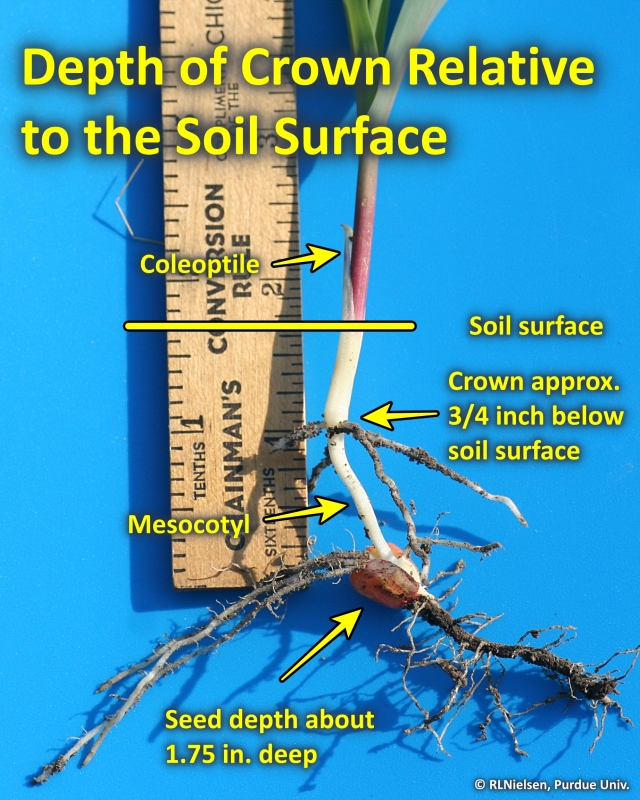
Typical crown depth relative to soil surface.
As with all of corn growth and development, germination and emergence are influenced by temperature, especially soil temperature. Corn typically requires from 100 to 120 Growing Degree Days (GDD, Fahrenheit) to emerge. Under warm soil conditions, the calendar time from planting to emergence can be as little as 4 days. Under cold soil conditions, emergence can take as long as four weeks.
Elongation of the mesocotyl elevates the coleoptile and its enclosed inner leaves towards the soil surface. The mesocotyl is the tubular, white, stemlike tissue connecting the seed and the base of the coleoptile. Technically, the mesocotyl is the first internode of the stem.
Useful Tip: Mesocotyls are thought to be physiologically capable of elongating successfully from at least a 6-inch planting depth. Realistically, corn can be planted at least three inches deep (if necessary to reach adequate moisture) and still emerge successfully.
As the coleoptile tip nears the soil surface, exposure to the red light component of solar radiation reduces the production of the growth-promoting hormone indoleacetic acid (IAA) from the coleoptile tip, which reduces the supply of IAA to the mesocotyl, and consequently elongation comes to a halt (Vanderhoef & Briggs, 1978; Barker-Bridges et al., 1998). Since the depth below the soil surface at which the coleoptile tip senses red light is fairly constant, the resulting depth of the crown (base) of the coleoptile is nearly the same (1/2 to 3/4 inch) for seeding depths of one inch or greater.
Useful Tip: When corn is seeded very shallow (less than about 1/2 inch), the crown of the coleoptile will naturally be closer to the soil surface, if not right at the surface. Subsequent development of the nodal root system can be restricted by exposure to high temperatures and dry surface soils.
The coleoptile tissue is wrapped somewhat like inner leaves are wrapped, or rolled, in the whorl. Expansion of the inner true leaves eventually forces the coleoptile to partially unwrap near the tip, allowing the first true leaf to emerge. If mesocotyl elongation has successfully elevated the coleoptile tip to the soil surface, emergence of the first true leaves will also occur successfully at or just above the soil surface.
Several factors can cause the coleoptile to split prematurely, allowing the leaves to emerge underground. Usually, more than one of the following factors are present when this problem occurs, making it difficult to place the blame on any one factor.
Useful Tip: The mesocotyl should remain firm, white and healthy through at least the 6-leaf stage, if not longer. If it is mushy, discolored, or damaged prior to this stage, then it is likely part of the crop problem being investigated.
Click image to view larger version in a popup window. Left or right arrow on your keypad will cycle through the popup images.
Abendroth, L.J., R.W Elmore, M.J. Boyer, and S.K. Marlay. 2011. Corn Growth and Development. Iowa State Univ. Extension Publication #PMR-1009. https://store.extension.iastate.edu/Product/Corn-Growth-and-Development [URL accessed Apr 2020].
Barker-Bridgers M., D.M. Ribnicky, J.D. Cohen, and A.M. Jones. 1998. Red-light-regulated growth: Changes in the abundance of indoleacetic acid in the maize (Zea mays L.) mesocotyl. Planta 204: 207-211
Nielsen, RL (Bob). 2017. Heat Unit Concepts Related to Corn Development. Corny News Network, Purdue Univ. http://www.kingcorn.org/news/timeless/HeatUnits.html. [URL accessed Apr 2020].
Nielsen, RL (Bob). 2019. Corkscrewed Corn Seedlings. Corny News Network, Purdue Univ. http://www.kingcorn.org/news/articles/timeless/Cornscrews.html. [URL accessed Apr 2020].
Nielsen, RL (Bob). 2019. Visual Indicators of Germination in Corn. Corny News Network, Purdue Univ. http://www.kingcorn.org/news/timeless/GerminationEvents.html. [URL accessed Apr 2020].
Nielsen, RL (Bob). 2020. Requirements for Uniform Germination and Emergence of Corn. Corny News Network, Purdue Univ. http://www.kingcorn.org/news/timeless/GermEmergReq.html. [URL accessed Apr 2020].
Vanderhoef, Larry N., and Winslow R. Briggs. 1978. Red Light-inhibited Mesocotyl Elongation in Maize Seedlings. I. The Auxin Hypothesis. Plant Physiology 61: 534-537.